Assessment 2: Computer Organization and Architecture Report Analysis
VerifiedAdded on 2022/11/14
|14
|2395
|292
Report
AI Summary
This report delves into the intricacies of computer organization and architecture, providing a comprehensive analysis of operating system concepts. The report examines job scheduling procedures, exploring various algorithms such as FCFS, SJN, SJF, and Round Robin, and calculates waiting and turnaround times for each. It also addresses deadlock scenarios, including a banking system example, and discusses techniques to prevent and resolve deadlocks. Furthermore, the report analyzes a directed resource graph to determine deadlock status and blocked processes. The document concludes with a discussion on the importance of understanding operating system procedures for efficient system operation and provides relevant bibliographical references.
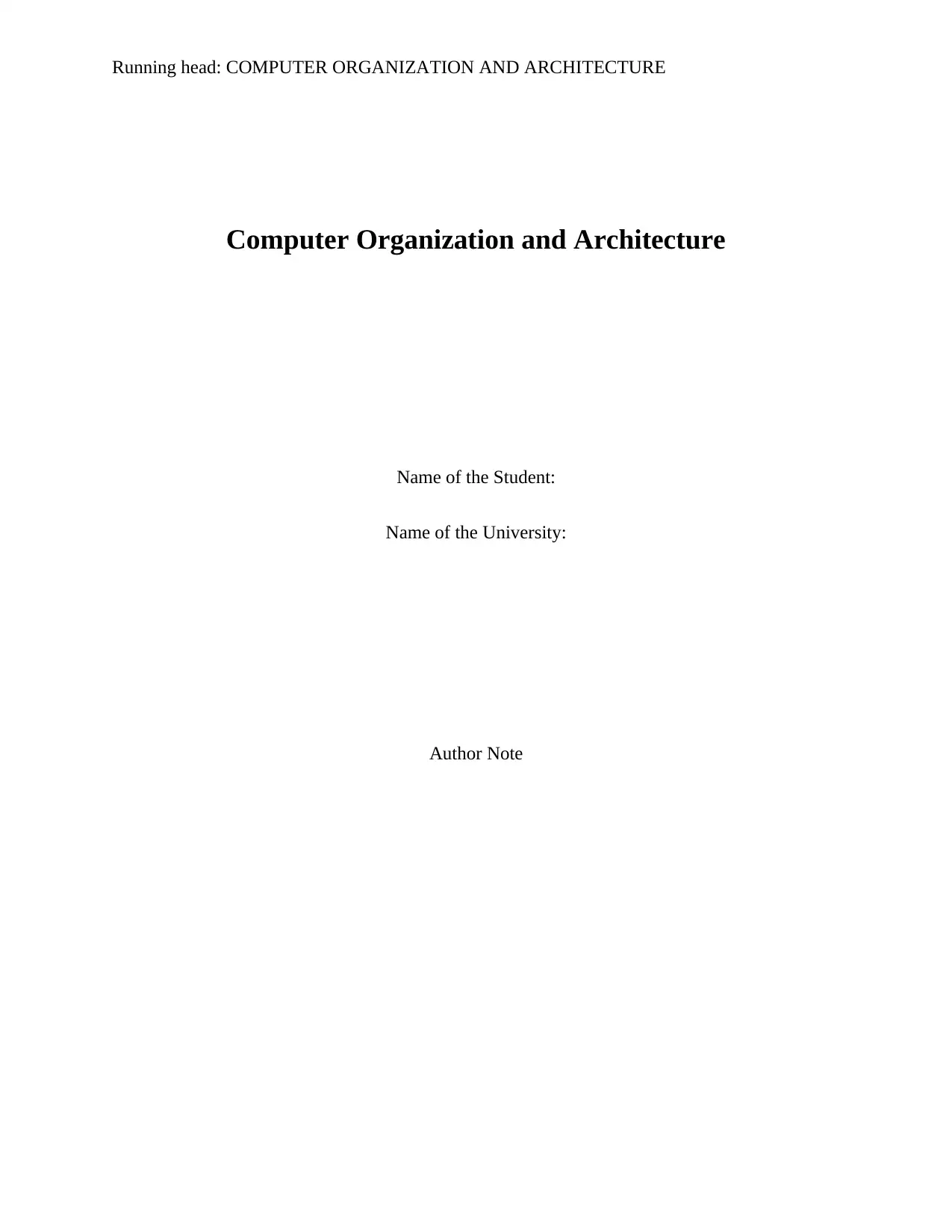
Running head: COMPUTER ORGANIZATION AND ARCHITECTURE
Computer Organization and Architecture
Name of the Student:
Name of the University:
Author Note
Computer Organization and Architecture
Name of the Student:
Name of the University:
Author Note
Paraphrase This Document
Need a fresh take? Get an instant paraphrase of this document with our AI Paraphraser
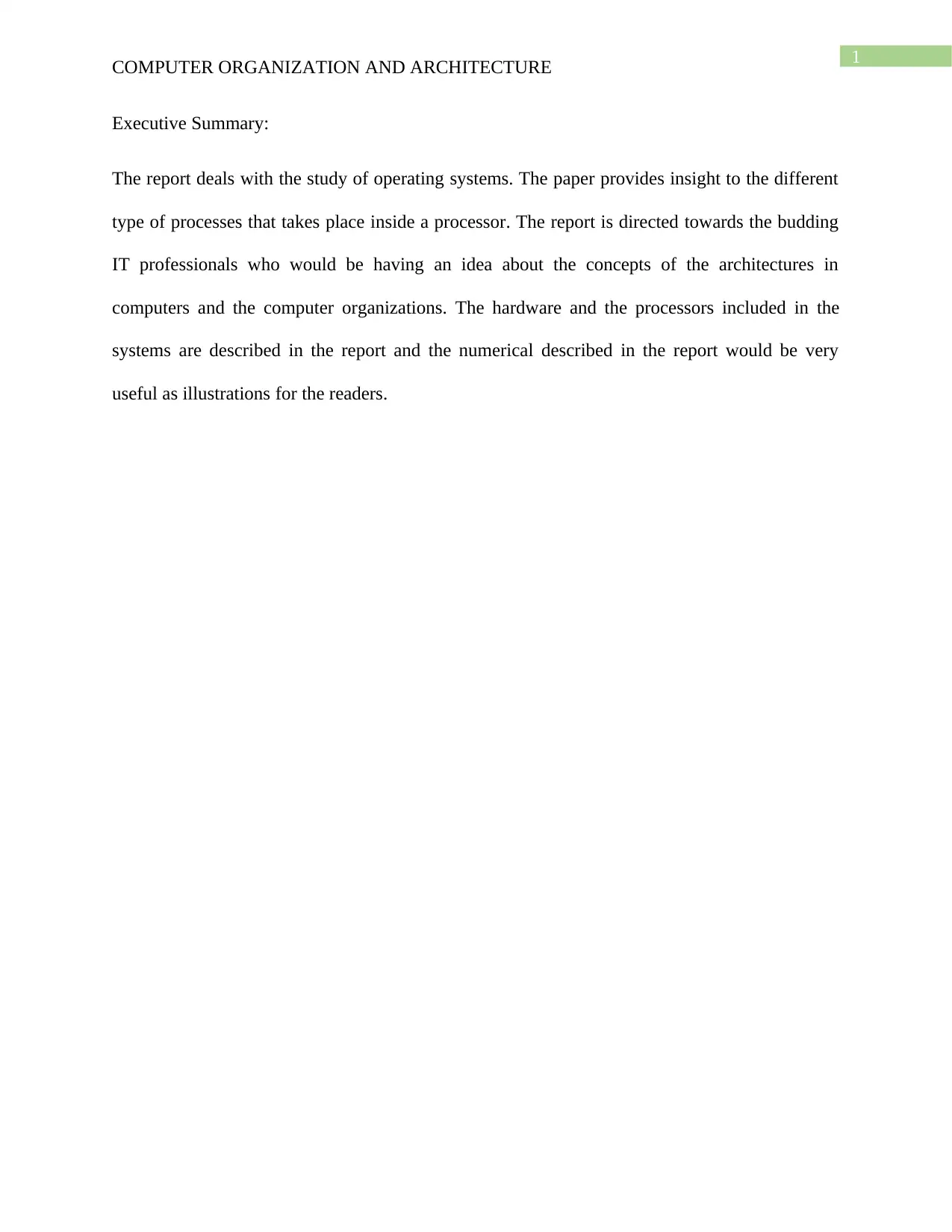
1
COMPUTER ORGANIZATION AND ARCHITECTURE
Executive Summary:
The report deals with the study of operating systems. The paper provides insight to the different
type of processes that takes place inside a processor. The report is directed towards the budding
IT professionals who would be having an idea about the concepts of the architectures in
computers and the computer organizations. The hardware and the processors included in the
systems are described in the report and the numerical described in the report would be very
useful as illustrations for the readers.
COMPUTER ORGANIZATION AND ARCHITECTURE
Executive Summary:
The report deals with the study of operating systems. The paper provides insight to the different
type of processes that takes place inside a processor. The report is directed towards the budding
IT professionals who would be having an idea about the concepts of the architectures in
computers and the computer organizations. The hardware and the processors included in the
systems are described in the report and the numerical described in the report would be very
useful as illustrations for the readers.
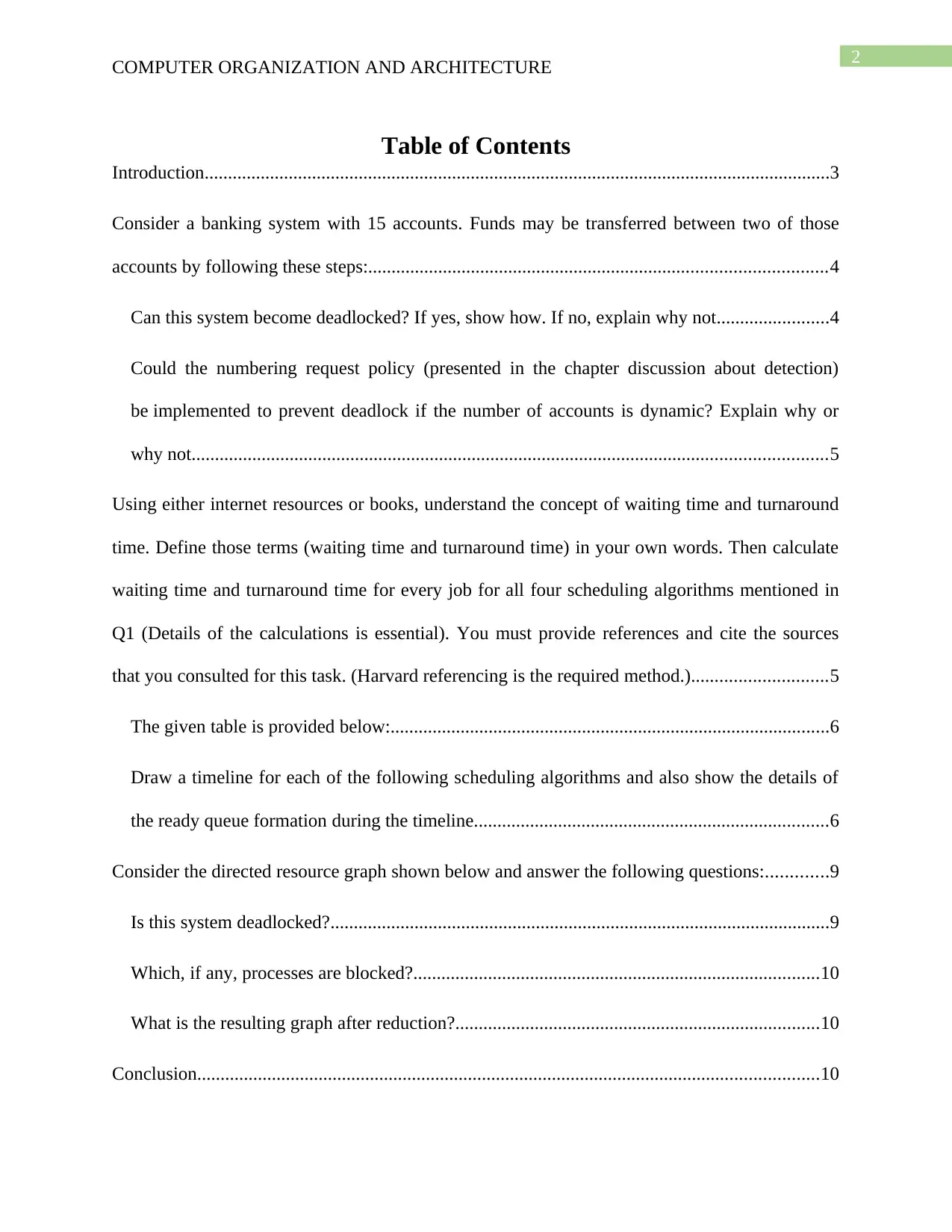
2
COMPUTER ORGANIZATION AND ARCHITECTURE
Table of Contents
Introduction......................................................................................................................................3
Consider a banking system with 15 accounts. Funds may be transferred between two of those
accounts by following these steps:..................................................................................................4
Can this system become deadlocked? If yes, show how. If no, explain why not........................4
Could the numbering request policy (presented in the chapter discussion about detection)
be implemented to prevent deadlock if the number of accounts is dynamic? Explain why or
why not........................................................................................................................................5
Using either internet resources or books, understand the concept of waiting time and turnaround
time. Define those terms (waiting time and turnaround time) in your own words. Then calculate
waiting time and turnaround time for every job for all four scheduling algorithms mentioned in
Q1 (Details of the calculations is essential). You must provide references and cite the sources
that you consulted for this task. (Harvard referencing is the required method.).............................5
The given table is provided below:..............................................................................................6
Draw a timeline for each of the following scheduling algorithms and also show the details of
the ready queue formation during the timeline............................................................................6
Consider the directed resource graph shown below and answer the following questions:.............9
Is this system deadlocked?...........................................................................................................9
Which, if any, processes are blocked?.......................................................................................10
What is the resulting graph after reduction?..............................................................................10
Conclusion.....................................................................................................................................10
COMPUTER ORGANIZATION AND ARCHITECTURE
Table of Contents
Introduction......................................................................................................................................3
Consider a banking system with 15 accounts. Funds may be transferred between two of those
accounts by following these steps:..................................................................................................4
Can this system become deadlocked? If yes, show how. If no, explain why not........................4
Could the numbering request policy (presented in the chapter discussion about detection)
be implemented to prevent deadlock if the number of accounts is dynamic? Explain why or
why not........................................................................................................................................5
Using either internet resources or books, understand the concept of waiting time and turnaround
time. Define those terms (waiting time and turnaround time) in your own words. Then calculate
waiting time and turnaround time for every job for all four scheduling algorithms mentioned in
Q1 (Details of the calculations is essential). You must provide references and cite the sources
that you consulted for this task. (Harvard referencing is the required method.).............................5
The given table is provided below:..............................................................................................6
Draw a timeline for each of the following scheduling algorithms and also show the details of
the ready queue formation during the timeline............................................................................6
Consider the directed resource graph shown below and answer the following questions:.............9
Is this system deadlocked?...........................................................................................................9
Which, if any, processes are blocked?.......................................................................................10
What is the resulting graph after reduction?..............................................................................10
Conclusion.....................................................................................................................................10
⊘ This is a preview!⊘
Do you want full access?
Subscribe today to unlock all pages.

Trusted by 1+ million students worldwide
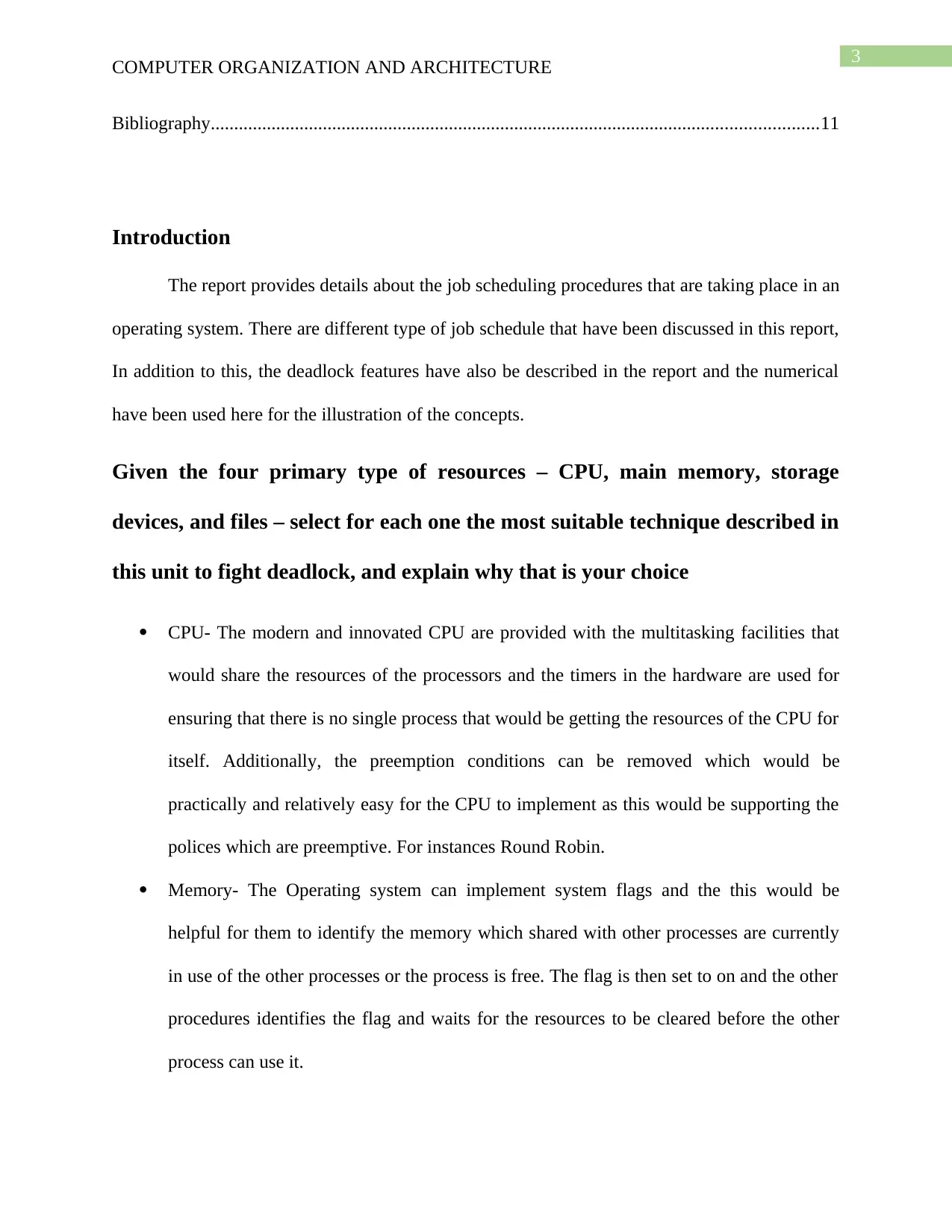
3
COMPUTER ORGANIZATION AND ARCHITECTURE
Bibliography..................................................................................................................................11
Introduction
The report provides details about the job scheduling procedures that are taking place in an
operating system. There are different type of job schedule that have been discussed in this report,
In addition to this, the deadlock features have also be described in the report and the numerical
have been used here for the illustration of the concepts.
Given the four primary type of resources – CPU, main memory, storage
devices, and files – select for each one the most suitable technique described in
this unit to fight deadlock, and explain why that is your choice
CPU- The modern and innovated CPU are provided with the multitasking facilities that
would share the resources of the processors and the timers in the hardware are used for
ensuring that there is no single process that would be getting the resources of the CPU for
itself. Additionally, the preemption conditions can be removed which would be
practically and relatively easy for the CPU to implement as this would be supporting the
polices which are preemptive. For instances Round Robin.
Memory- The Operating system can implement system flags and the this would be
helpful for them to identify the memory which shared with other processes are currently
in use of the other processes or the process is free. The flag is then set to on and the other
procedures identifies the flag and waits for the resources to be cleared before the other
process can use it.
COMPUTER ORGANIZATION AND ARCHITECTURE
Bibliography..................................................................................................................................11
Introduction
The report provides details about the job scheduling procedures that are taking place in an
operating system. There are different type of job schedule that have been discussed in this report,
In addition to this, the deadlock features have also be described in the report and the numerical
have been used here for the illustration of the concepts.
Given the four primary type of resources – CPU, main memory, storage
devices, and files – select for each one the most suitable technique described in
this unit to fight deadlock, and explain why that is your choice
CPU- The modern and innovated CPU are provided with the multitasking facilities that
would share the resources of the processors and the timers in the hardware are used for
ensuring that there is no single process that would be getting the resources of the CPU for
itself. Additionally, the preemption conditions can be removed which would be
practically and relatively easy for the CPU to implement as this would be supporting the
polices which are preemptive. For instances Round Robin.
Memory- The Operating system can implement system flags and the this would be
helpful for them to identify the memory which shared with other processes are currently
in use of the other processes or the process is free. The flag is then set to on and the other
procedures identifies the flag and waits for the resources to be cleared before the other
process can use it.
Paraphrase This Document
Need a fresh take? Get an instant paraphrase of this document with our AI Paraphraser
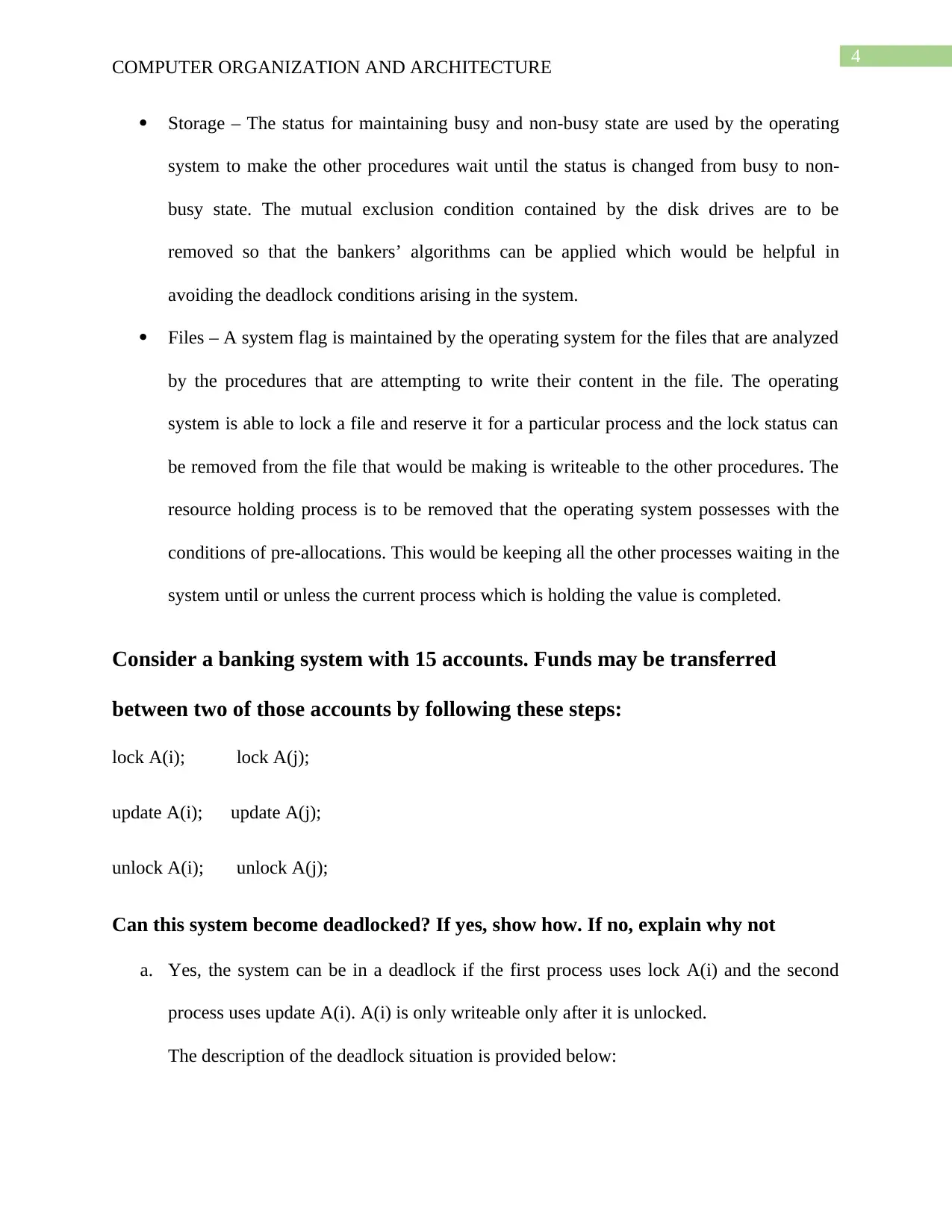
4
COMPUTER ORGANIZATION AND ARCHITECTURE
Storage – The status for maintaining busy and non-busy state are used by the operating
system to make the other procedures wait until the status is changed from busy to non-
busy state. The mutual exclusion condition contained by the disk drives are to be
removed so that the bankers’ algorithms can be applied which would be helpful in
avoiding the deadlock conditions arising in the system.
Files – A system flag is maintained by the operating system for the files that are analyzed
by the procedures that are attempting to write their content in the file. The operating
system is able to lock a file and reserve it for a particular process and the lock status can
be removed from the file that would be making is writeable to the other procedures. The
resource holding process is to be removed that the operating system possesses with the
conditions of pre-allocations. This would be keeping all the other processes waiting in the
system until or unless the current process which is holding the value is completed.
Consider a banking system with 15 accounts. Funds may be transferred
between two of those accounts by following these steps:
lock A(i); lock A(j);
update A(i); update A(j);
unlock A(i); unlock A(j);
Can this system become deadlocked? If yes, show how. If no, explain why not
a. Yes, the system can be in a deadlock if the first process uses lock A(i) and the second
process uses update A(i). A(i) is only writeable only after it is unlocked.
The description of the deadlock situation is provided below:
COMPUTER ORGANIZATION AND ARCHITECTURE
Storage – The status for maintaining busy and non-busy state are used by the operating
system to make the other procedures wait until the status is changed from busy to non-
busy state. The mutual exclusion condition contained by the disk drives are to be
removed so that the bankers’ algorithms can be applied which would be helpful in
avoiding the deadlock conditions arising in the system.
Files – A system flag is maintained by the operating system for the files that are analyzed
by the procedures that are attempting to write their content in the file. The operating
system is able to lock a file and reserve it for a particular process and the lock status can
be removed from the file that would be making is writeable to the other procedures. The
resource holding process is to be removed that the operating system possesses with the
conditions of pre-allocations. This would be keeping all the other processes waiting in the
system until or unless the current process which is holding the value is completed.
Consider a banking system with 15 accounts. Funds may be transferred
between two of those accounts by following these steps:
lock A(i); lock A(j);
update A(i); update A(j);
unlock A(i); unlock A(j);
Can this system become deadlocked? If yes, show how. If no, explain why not
a. Yes, the system can be in a deadlock if the first process uses lock A(i) and the second
process uses update A(i). A(i) is only writeable only after it is unlocked.
The description of the deadlock situation is provided below:
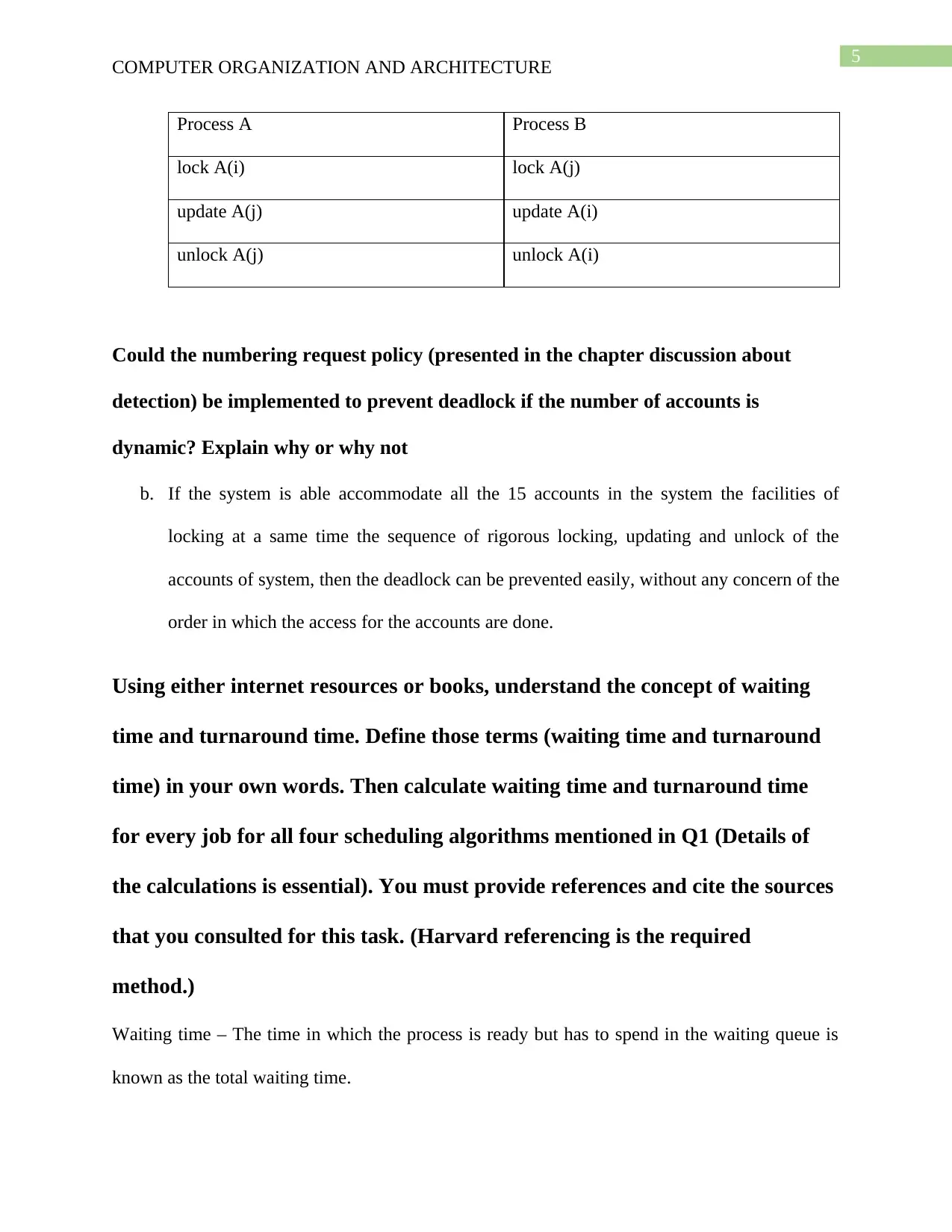
5
COMPUTER ORGANIZATION AND ARCHITECTURE
Process A Process B
lock A(i) lock A(j)
update A(j) update A(i)
unlock A(j) unlock A(i)
Could the numbering request policy (presented in the chapter discussion about
detection) be implemented to prevent deadlock if the number of accounts is
dynamic? Explain why or why not
b. If the system is able accommodate all the 15 accounts in the system the facilities of
locking at a same time the sequence of rigorous locking, updating and unlock of the
accounts of system, then the deadlock can be prevented easily, without any concern of the
order in which the access for the accounts are done.
Using either internet resources or books, understand the concept of waiting
time and turnaround time. Define those terms (waiting time and turnaround
time) in your own words. Then calculate waiting time and turnaround time
for every job for all four scheduling algorithms mentioned in Q1 (Details of
the calculations is essential). You must provide references and cite the sources
that you consulted for this task. (Harvard referencing is the required
method.)
Waiting time – The time in which the process is ready but has to spend in the waiting queue is
known as the total waiting time.
COMPUTER ORGANIZATION AND ARCHITECTURE
Process A Process B
lock A(i) lock A(j)
update A(j) update A(i)
unlock A(j) unlock A(i)
Could the numbering request policy (presented in the chapter discussion about
detection) be implemented to prevent deadlock if the number of accounts is
dynamic? Explain why or why not
b. If the system is able accommodate all the 15 accounts in the system the facilities of
locking at a same time the sequence of rigorous locking, updating and unlock of the
accounts of system, then the deadlock can be prevented easily, without any concern of the
order in which the access for the accounts are done.
Using either internet resources or books, understand the concept of waiting
time and turnaround time. Define those terms (waiting time and turnaround
time) in your own words. Then calculate waiting time and turnaround time
for every job for all four scheduling algorithms mentioned in Q1 (Details of
the calculations is essential). You must provide references and cite the sources
that you consulted for this task. (Harvard referencing is the required
method.)
Waiting time – The time in which the process is ready but has to spend in the waiting queue is
known as the total waiting time.
⊘ This is a preview!⊘
Do you want full access?
Subscribe today to unlock all pages.

Trusted by 1+ million students worldwide
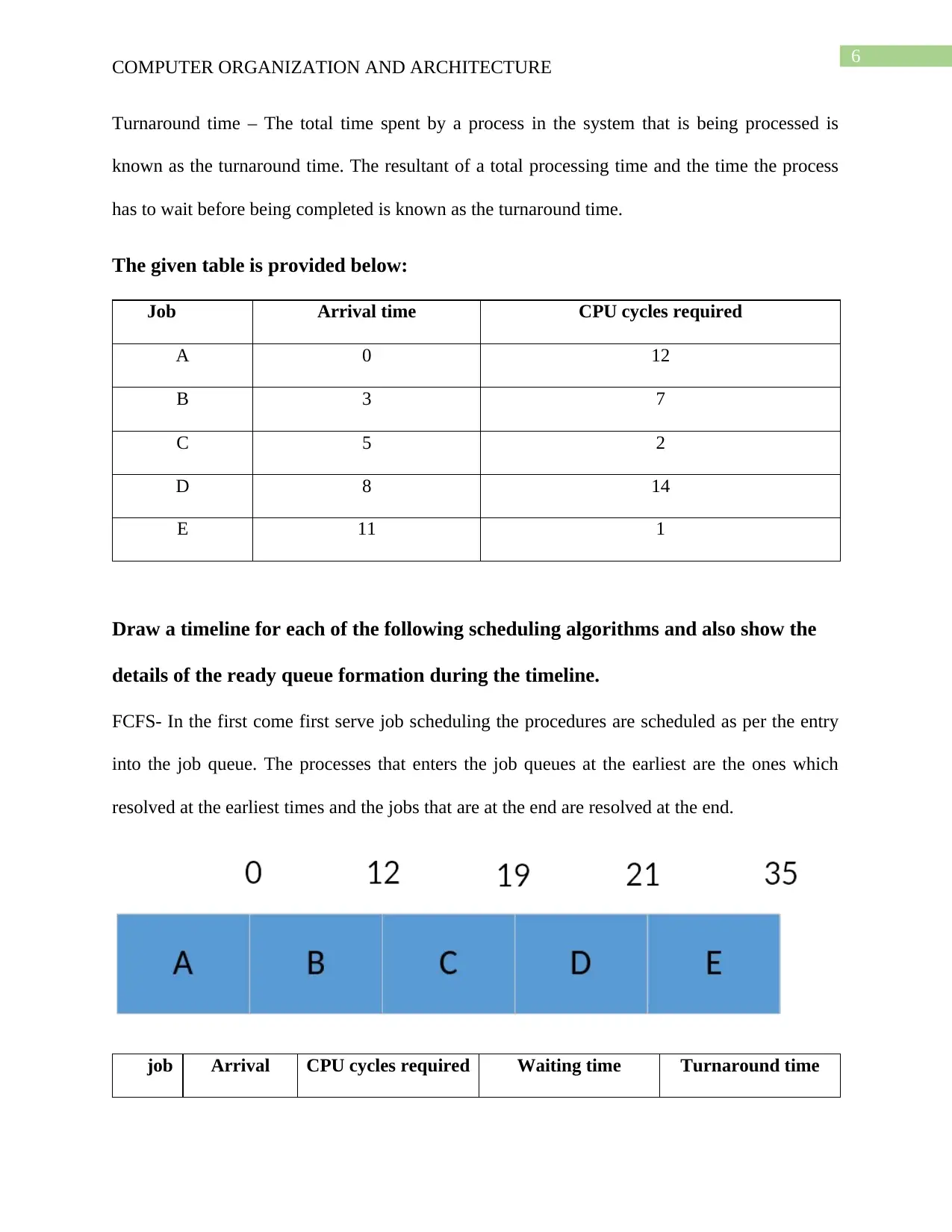
6
COMPUTER ORGANIZATION AND ARCHITECTURE
Turnaround time – The total time spent by a process in the system that is being processed is
known as the turnaround time. The resultant of a total processing time and the time the process
has to wait before being completed is known as the turnaround time.
The given table is provided below:
Job Arrival time CPU cycles required
A 0 12
B 3 7
C 5 2
D 8 14
E 11 1
Draw a timeline for each of the following scheduling algorithms and also show the
details of the ready queue formation during the timeline.
FCFS- In the first come first serve job scheduling the procedures are scheduled as per the entry
into the job queue. The processes that enters the job queues at the earliest are the ones which
resolved at the earliest times and the jobs that are at the end are resolved at the end.
job Arrival CPU cycles required Waiting time Turnaround time
COMPUTER ORGANIZATION AND ARCHITECTURE
Turnaround time – The total time spent by a process in the system that is being processed is
known as the turnaround time. The resultant of a total processing time and the time the process
has to wait before being completed is known as the turnaround time.
The given table is provided below:
Job Arrival time CPU cycles required
A 0 12
B 3 7
C 5 2
D 8 14
E 11 1
Draw a timeline for each of the following scheduling algorithms and also show the
details of the ready queue formation during the timeline.
FCFS- In the first come first serve job scheduling the procedures are scheduled as per the entry
into the job queue. The processes that enters the job queues at the earliest are the ones which
resolved at the earliest times and the jobs that are at the end are resolved at the end.
job Arrival CPU cycles required Waiting time Turnaround time
Paraphrase This Document
Need a fresh take? Get an instant paraphrase of this document with our AI Paraphraser
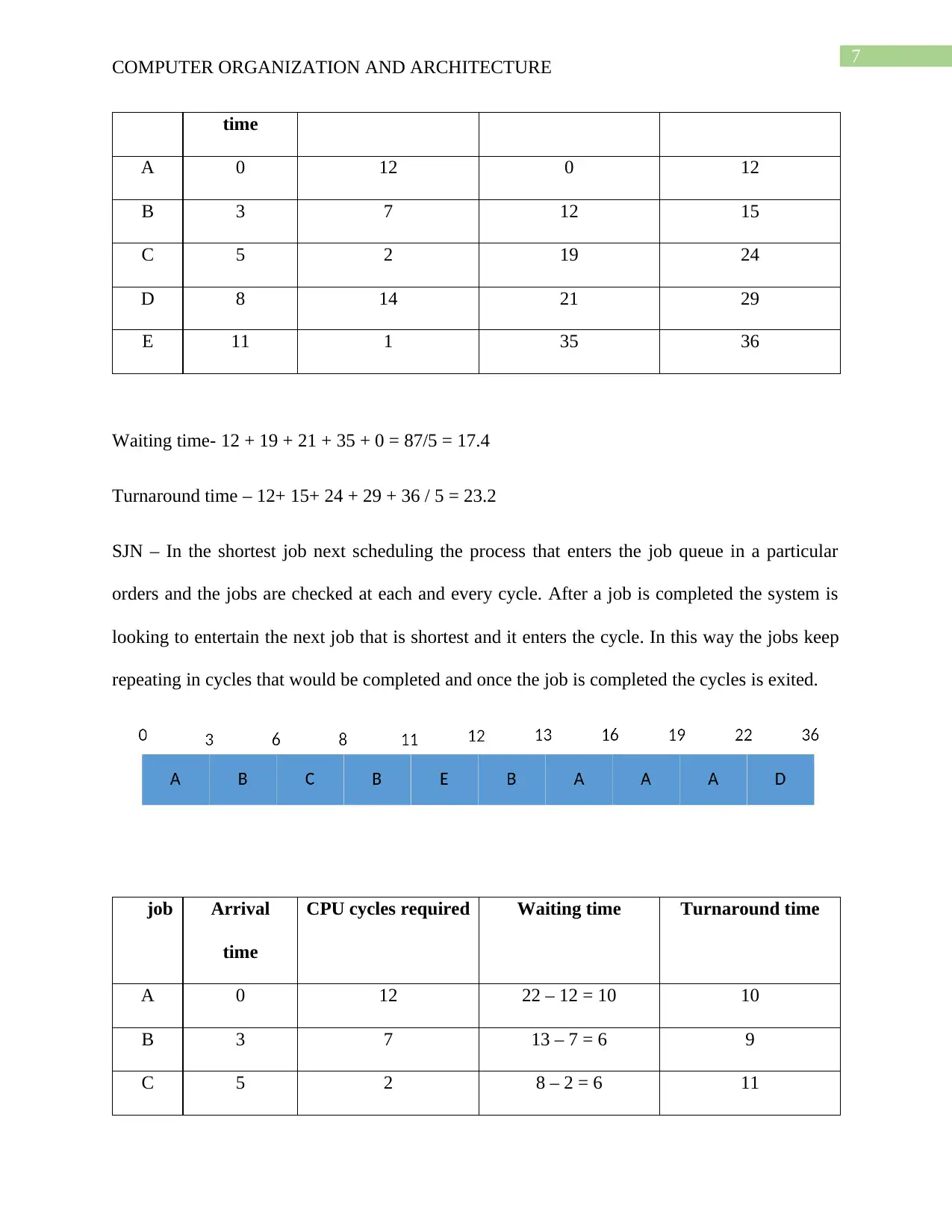
7
COMPUTER ORGANIZATION AND ARCHITECTURE
time
A 0 12 0 12
B 3 7 12 15
C 5 2 19 24
D 8 14 21 29
E 11 1 35 36
Waiting time- 12 + 19 + 21 + 35 + 0 = 87/5 = 17.4
Turnaround time – 12+ 15+ 24 + 29 + 36 / 5 = 23.2
SJN – In the shortest job next scheduling the process that enters the job queue in a particular
orders and the jobs are checked at each and every cycle. After a job is completed the system is
looking to entertain the next job that is shortest and it enters the cycle. In this way the jobs keep
repeating in cycles that would be completed and once the job is completed the cycles is exited.
job Arrival
time
CPU cycles required Waiting time Turnaround time
A 0 12 22 – 12 = 10 10
B 3 7 13 – 7 = 6 9
C 5 2 8 – 2 = 6 11
COMPUTER ORGANIZATION AND ARCHITECTURE
time
A 0 12 0 12
B 3 7 12 15
C 5 2 19 24
D 8 14 21 29
E 11 1 35 36
Waiting time- 12 + 19 + 21 + 35 + 0 = 87/5 = 17.4
Turnaround time – 12+ 15+ 24 + 29 + 36 / 5 = 23.2
SJN – In the shortest job next scheduling the process that enters the job queue in a particular
orders and the jobs are checked at each and every cycle. After a job is completed the system is
looking to entertain the next job that is shortest and it enters the cycle. In this way the jobs keep
repeating in cycles that would be completed and once the job is completed the cycles is exited.
job Arrival
time
CPU cycles required Waiting time Turnaround time
A 0 12 22 – 12 = 10 10
B 3 7 13 – 7 = 6 9
C 5 2 8 – 2 = 6 11
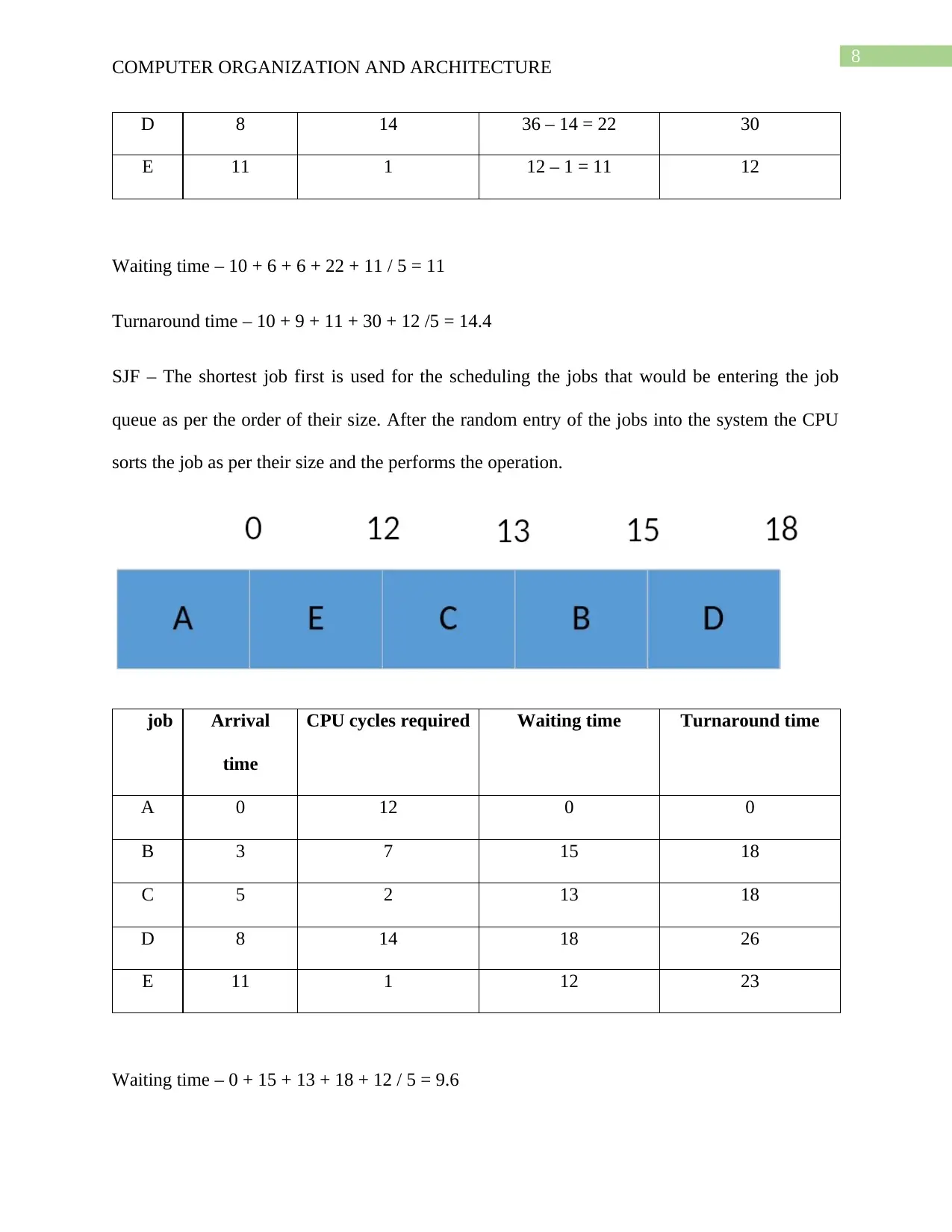
8
COMPUTER ORGANIZATION AND ARCHITECTURE
D 8 14 36 – 14 = 22 30
E 11 1 12 – 1 = 11 12
Waiting time – 10 + 6 + 6 + 22 + 11 / 5 = 11
Turnaround time – 10 + 9 + 11 + 30 + 12 /5 = 14.4
SJF – The shortest job first is used for the scheduling the jobs that would be entering the job
queue as per the order of their size. After the random entry of the jobs into the system the CPU
sorts the job as per their size and the performs the operation.
job Arrival
time
CPU cycles required Waiting time Turnaround time
A 0 12 0 0
B 3 7 15 18
C 5 2 13 18
D 8 14 18 26
E 11 1 12 23
Waiting time – 0 + 15 + 13 + 18 + 12 / 5 = 9.6
COMPUTER ORGANIZATION AND ARCHITECTURE
D 8 14 36 – 14 = 22 30
E 11 1 12 – 1 = 11 12
Waiting time – 10 + 6 + 6 + 22 + 11 / 5 = 11
Turnaround time – 10 + 9 + 11 + 30 + 12 /5 = 14.4
SJF – The shortest job first is used for the scheduling the jobs that would be entering the job
queue as per the order of their size. After the random entry of the jobs into the system the CPU
sorts the job as per their size and the performs the operation.
job Arrival
time
CPU cycles required Waiting time Turnaround time
A 0 12 0 0
B 3 7 15 18
C 5 2 13 18
D 8 14 18 26
E 11 1 12 23
Waiting time – 0 + 15 + 13 + 18 + 12 / 5 = 9.6
⊘ This is a preview!⊘
Do you want full access?
Subscribe today to unlock all pages.

Trusted by 1+ million students worldwide
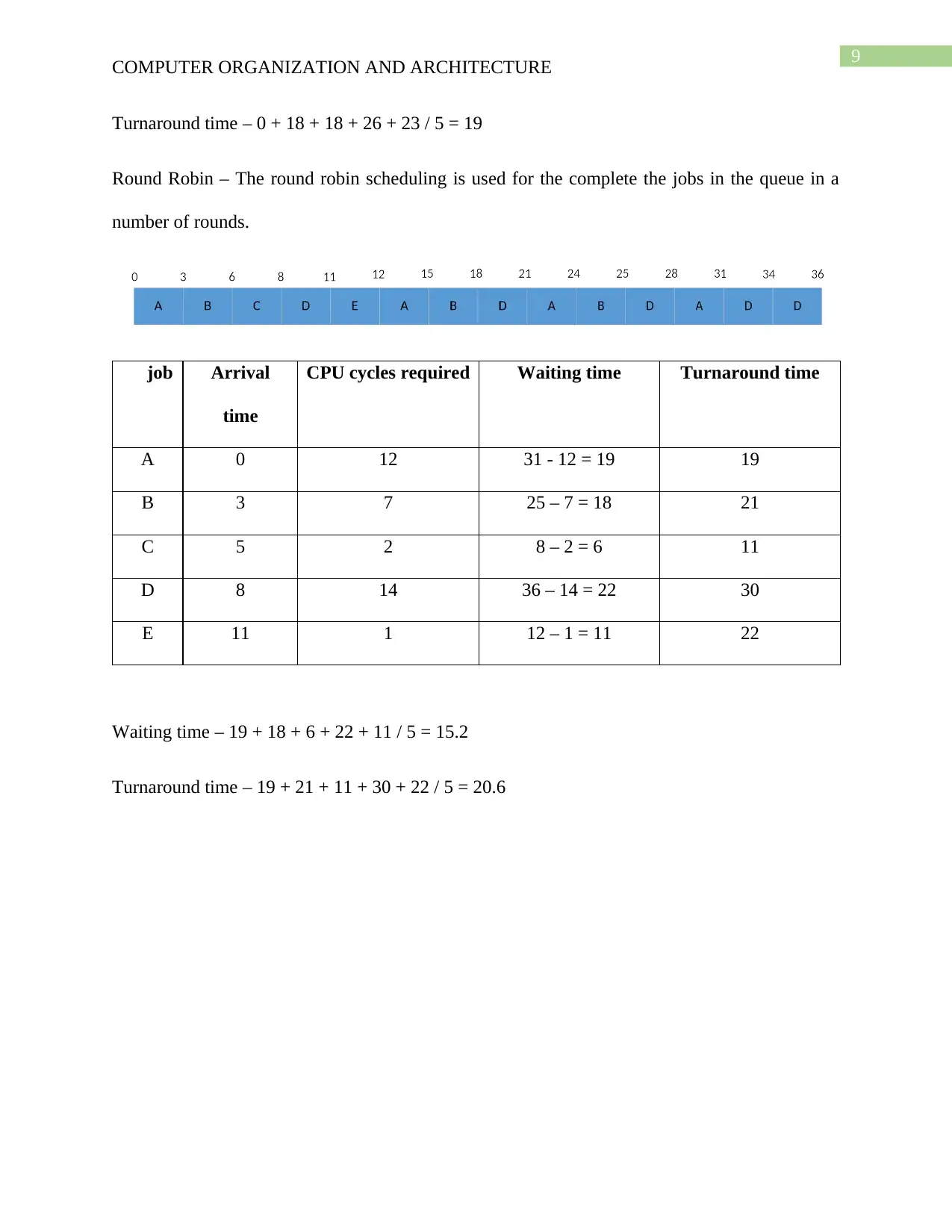
9
COMPUTER ORGANIZATION AND ARCHITECTURE
Turnaround time – 0 + 18 + 18 + 26 + 23 / 5 = 19
Round Robin – The round robin scheduling is used for the complete the jobs in the queue in a
number of rounds.
job Arrival
time
CPU cycles required Waiting time Turnaround time
A 0 12 31 - 12 = 19 19
B 3 7 25 – 7 = 18 21
C 5 2 8 – 2 = 6 11
D 8 14 36 – 14 = 22 30
E 11 1 12 – 1 = 11 22
Waiting time – 19 + 18 + 6 + 22 + 11 / 5 = 15.2
Turnaround time – 19 + 21 + 11 + 30 + 22 / 5 = 20.6
COMPUTER ORGANIZATION AND ARCHITECTURE
Turnaround time – 0 + 18 + 18 + 26 + 23 / 5 = 19
Round Robin – The round robin scheduling is used for the complete the jobs in the queue in a
number of rounds.
job Arrival
time
CPU cycles required Waiting time Turnaround time
A 0 12 31 - 12 = 19 19
B 3 7 25 – 7 = 18 21
C 5 2 8 – 2 = 6 11
D 8 14 36 – 14 = 22 30
E 11 1 12 – 1 = 11 22
Waiting time – 19 + 18 + 6 + 22 + 11 / 5 = 15.2
Turnaround time – 19 + 21 + 11 + 30 + 22 / 5 = 20.6
Paraphrase This Document
Need a fresh take? Get an instant paraphrase of this document with our AI Paraphraser
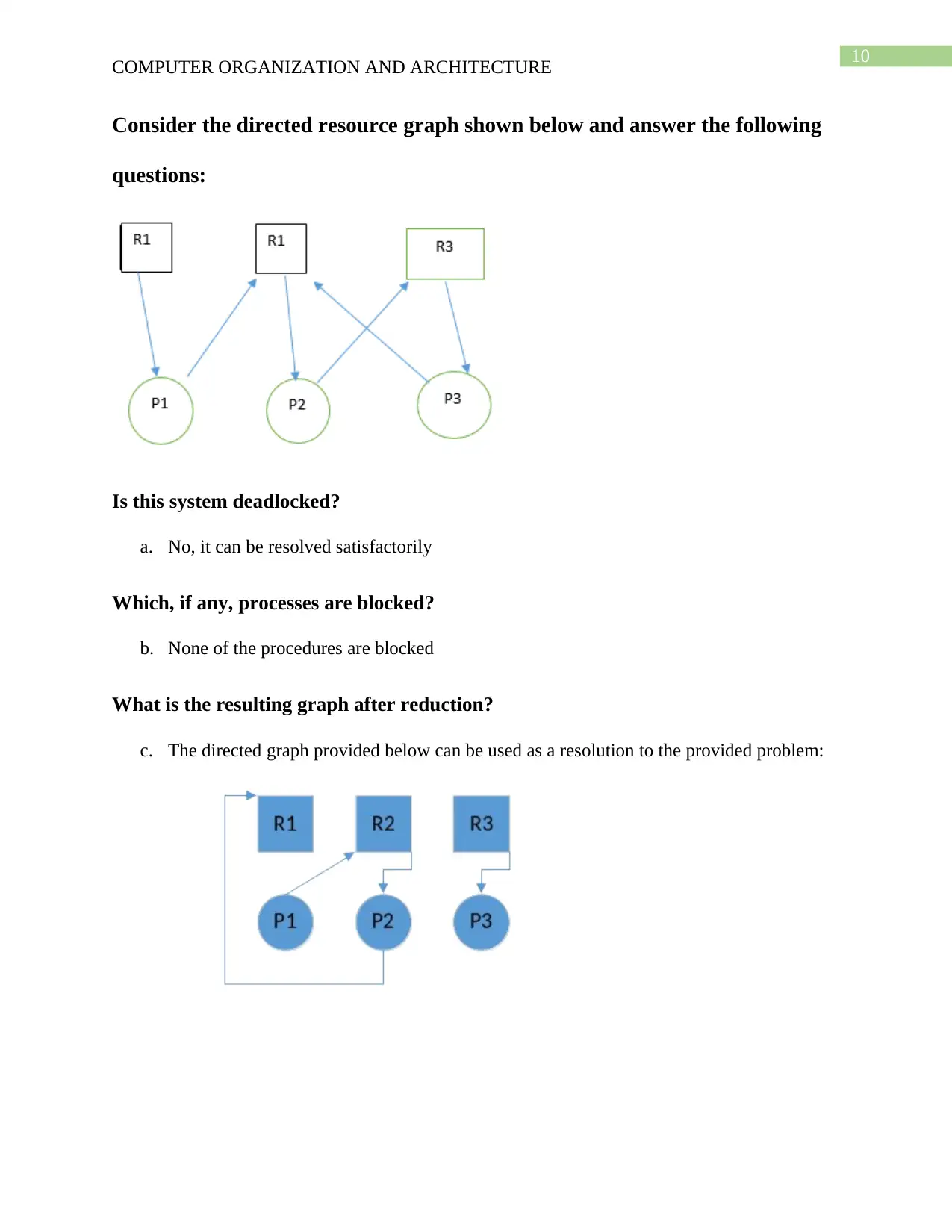
10
COMPUTER ORGANIZATION AND ARCHITECTURE
Consider the directed resource graph shown below and answer the following
questions:
Is this system deadlocked?
a. No, it can be resolved satisfactorily
Which, if any, processes are blocked?
b. None of the procedures are blocked
What is the resulting graph after reduction?
c. The directed graph provided below can be used as a resolution to the provided problem:
COMPUTER ORGANIZATION AND ARCHITECTURE
Consider the directed resource graph shown below and answer the following
questions:
Is this system deadlocked?
a. No, it can be resolved satisfactorily
Which, if any, processes are blocked?
b. None of the procedures are blocked
What is the resulting graph after reduction?
c. The directed graph provided below can be used as a resolution to the provided problem:
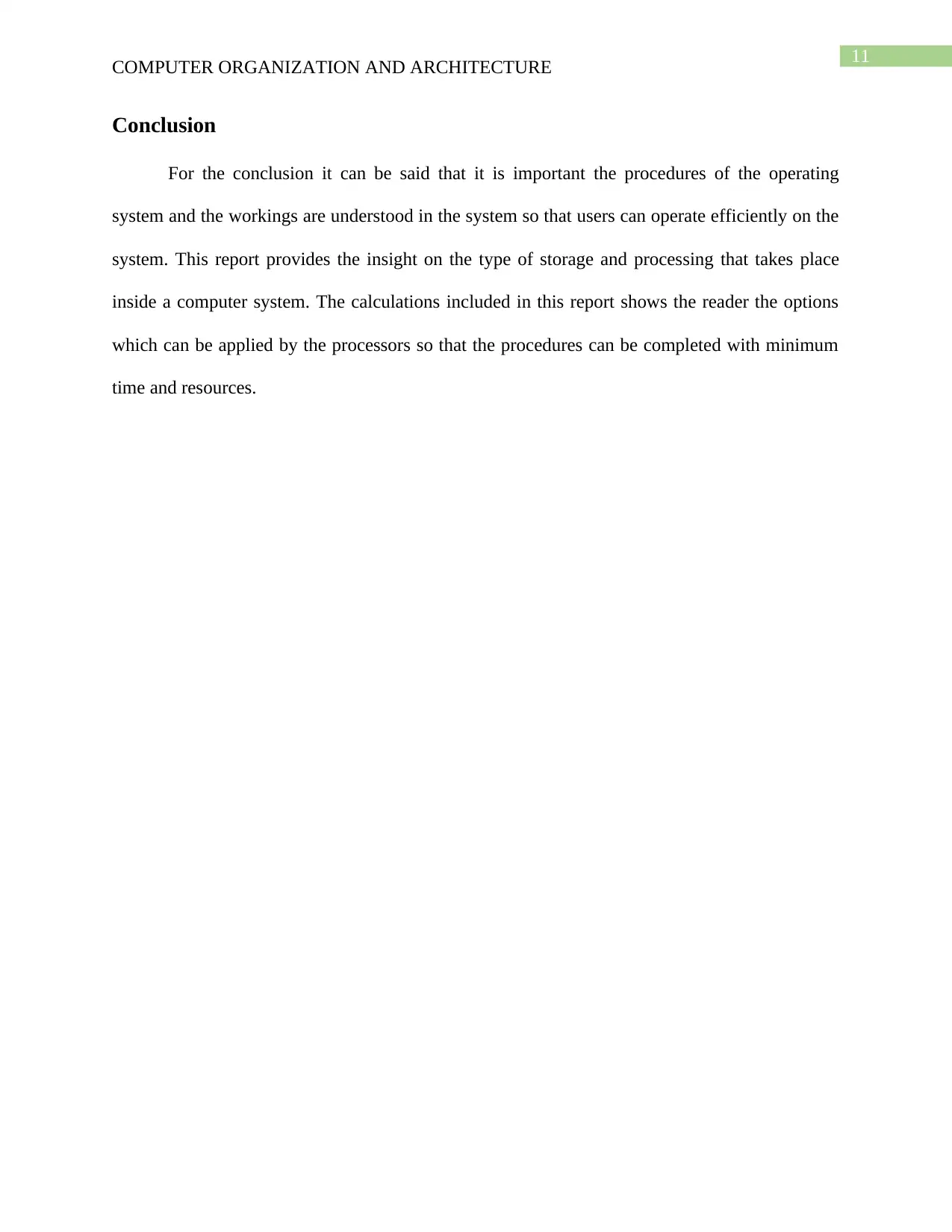
11
COMPUTER ORGANIZATION AND ARCHITECTURE
Conclusion
For the conclusion it can be said that it is important the procedures of the operating
system and the workings are understood in the system so that users can operate efficiently on the
system. This report provides the insight on the type of storage and processing that takes place
inside a computer system. The calculations included in this report shows the reader the options
which can be applied by the processors so that the procedures can be completed with minimum
time and resources.
COMPUTER ORGANIZATION AND ARCHITECTURE
Conclusion
For the conclusion it can be said that it is important the procedures of the operating
system and the workings are understood in the system so that users can operate efficiently on the
system. This report provides the insight on the type of storage and processing that takes place
inside a computer system. The calculations included in this report shows the reader the options
which can be applied by the processors so that the procedures can be completed with minimum
time and resources.
⊘ This is a preview!⊘
Do you want full access?
Subscribe today to unlock all pages.

Trusted by 1+ million students worldwide
1 out of 14
Related Documents
Your All-in-One AI-Powered Toolkit for Academic Success.
+13062052269
info@desklib.com
Available 24*7 on WhatsApp / Email
![[object Object]](/_next/static/media/star-bottom.7253800d.svg)
Unlock your academic potential
Copyright © 2020–2025 A2Z Services. All Rights Reserved. Developed and managed by ZUCOL.




